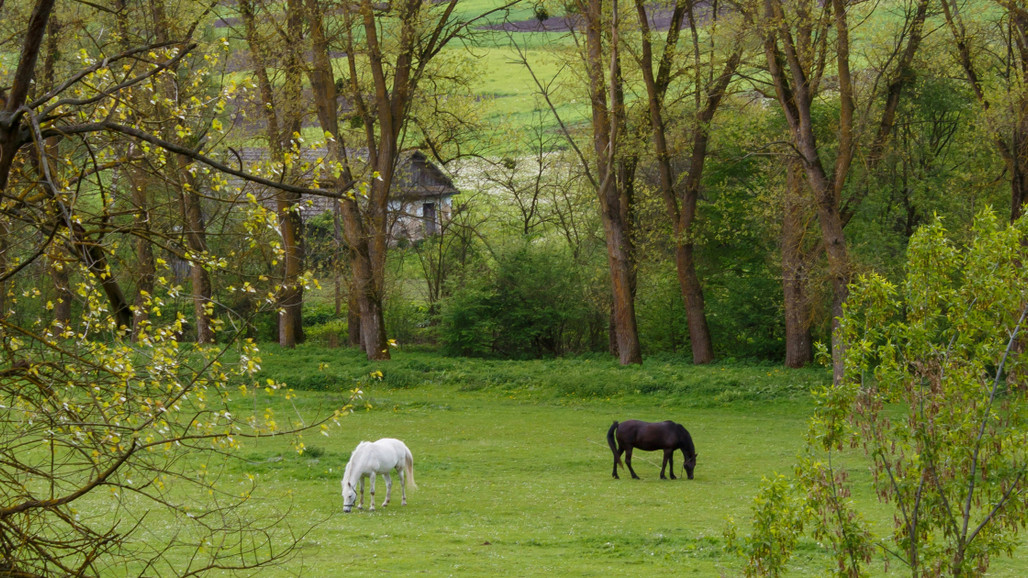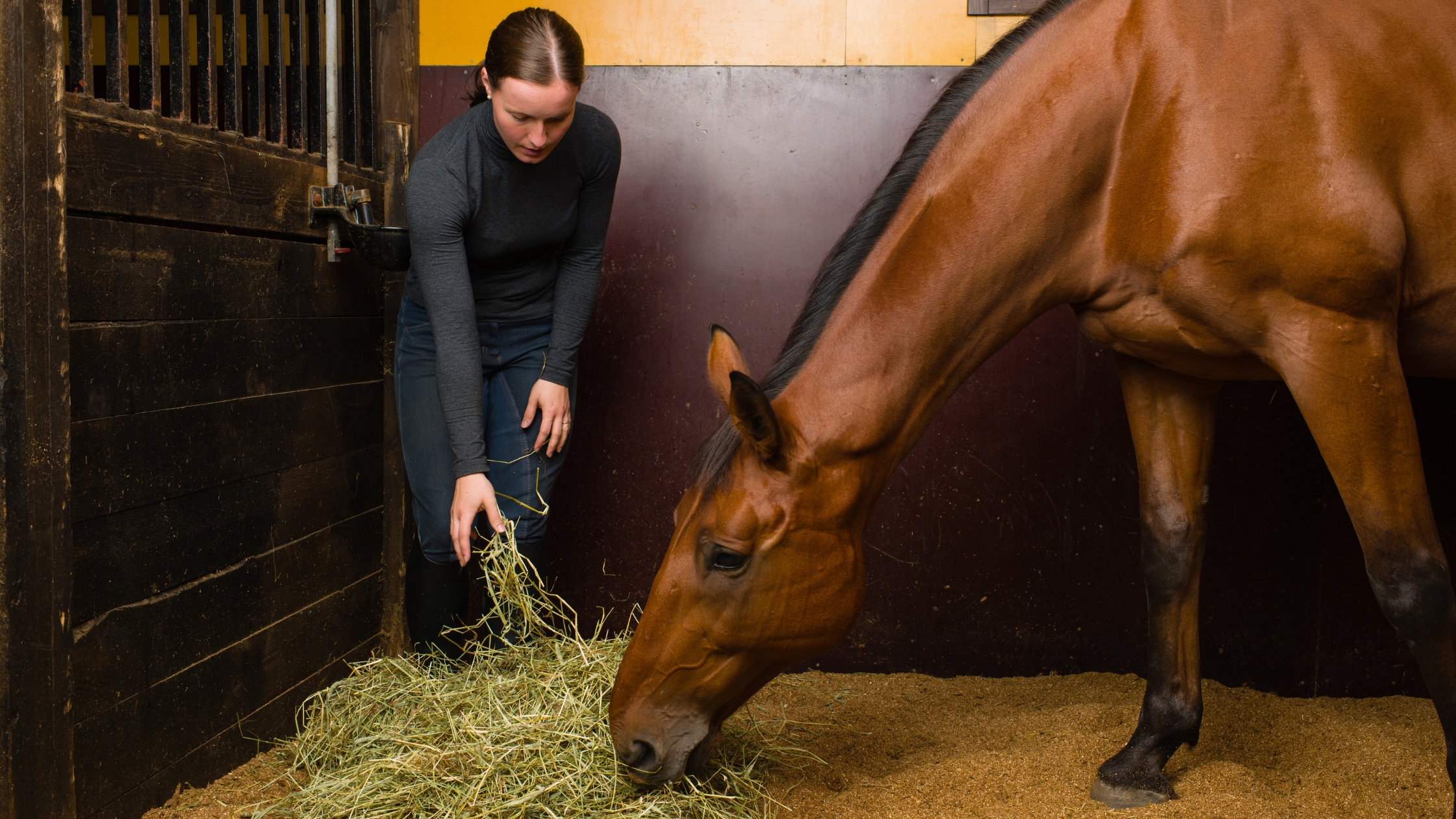
Keep Calm and Feed On - The Importance of Horse Nutrition in the Spring
Posted by Jennifer McClelland on 1st Apr 2024
Ah, Pure Michigan, there’s nothing like using all the weather emojis in the same month! Mother Nature is a force to be reckoned with lately, and she is not bashful about showing her extreme sides. This weather can make us horse people feel unprepared, defeated, and even desperate at times, as we focus on caring for our horses in the best way possible.
As horse lovers, we are really good at anthropomorphism (attributing human characteristics or behaviors to animals). With that said, some practices can be beneficial, while others can be detrimental. Our need to show them love, with extra feed items they do not normally get, is something to keep in check. Small amounts are ok, as long as it is a gradual increase. And remember, bran mashes do not make horses warm.
Food is definitely most horse’s love language. Everything in moderation works well for our monogastric hindgut fiber fermenters. With some basic knowledge of horse nutrition, we can take control of their diet and feed appropriately to keep colic at bay during this “Spring-Summer-Winter-Spring” season. Then, when the big weather fluctuations hit, just take a deep breath and remember to keep calm and feed on.
FEEDING STRATEGIES
The National Research Council (NRC), which is the standard in equine nutrition, calculates daily requirements for horses. You may be surprised to know that customized diets are broken down into 34 life stages/work levels to determine correctly balanced horse nutrition. Each group is also categorized by body weight. Looking at the charts can be very confusing and overwhelming so it’s no wonder why horse owners are constantly second-guessing their feed programs.
The council established 21 values of nutrients and these values are based on the life stage/workload of a horse. It’s bewildering to know that these requirements have not changed since 2007, which was only the 6th revision made since 1949! The one value most veterinarians and nutrition advisers would object to is the amount of Vitamin E needed. We now target 1,000 iu to ensure a balanced diet for horses, especially when not on pasture. Here are some feeding tips, based on the NRC, that you may find useful to incorporate best practices into your feed program.
Here are a few DOs/DON’Ts to note for a happy hindgut.
THE DON’TS
DON’T make any sudden changes in concentrates, balancers or forage, especially in times of weather swings. Most horse lovers think that changing your “grain” is worse than changing your forage, however, a homeostatic environment in the hindgut is essential to help prevent colic. The fact is, quick forage changes are the most important thing to avoid.
Changes in quantity or in the physical form should be implemented gradually. This practice allows the digestive tract time to adapt to different levels and avoids distressing the “good bugs”. A swift change can make the once-happy hindgut turn into a place of digestive turbulence.
DON’T introduce the latest supplement for horses to act as a bandaid for a hole in your nutrition or to fix a problem that arises. The vast majority of supplements are not thoroughly researched nor do they receive oversight by governmental agencies for quality or efficacy. Chances are they won’t harm your horse, but there is very little evidence to support they will help your horse. Trust your veterinarian or equine nutrition adviser to make a solid recommendation if a supplement is needed.
THE DOs
DO keep your normal feed routine and stay the course. What seems like uncomfortable weather to us, rarely has the same effect on the majority of equines.
DO keep their normal water intake levels consistent during weather warm-ups or cool-downs in any given week. If you can’t monitor how much your horse is drinking, try offering a 5-gallon bucket of fresh, lukewarm water every day. You can also add water to their feed. On average, horses should drink 10-12 gallons per day. Adding 1-2 Tbsp of salt to their feed will help keep them drinking.
DO keep forage in front of them for as long as possible. The contents of a horse’s stomach are emptied within 4-6 hours or so. Whether full or empty, the gastric acid to break down meals is always being produced by the lower glandular region. This means the acid is allowed to slosh around and come in contact with the unprotected squamous region (upper non-glandular part) which can then result in squamous ulcers. By keeping contents slowly entering the stomach, not only is the foregut happy, the hindgut is happy as well.

FORAGE FIRST
Depending on your horse’s BCS (body condition score based on the Henneke chart created in 1985), the NRC recommends feeding 2% of their body weight in hay. You should not go below 1.75% of body weight for “easy keepers” though and if a lot of weight gain is needed, you can offer unlimited. This means an average 1,100-pound horse should consume about 22 pounds of hay. Of course, the quality of hay can vary considerably, so testing your hay will reveal the RFV (relative feed value) as well as the DE (digestible energy), along with other key values.
Every bale differs in weight so it is crucial to weigh your hay to get a good idea of where to start. The simplest way to weigh your hay is by using a luggage scale or a fish scale and weighing hay placed in a plastic bag. By measuring out the appropriate amount, you’ll have an idea of how much to feed every day, and more importantly, how to spread out the amount so forage is continually being digested. Even overweight horses need continuous forage to keep their digestive tract healthy. The challenging part is to match the right forage with the right slow-feeding tools to manage the caloric/sugar and starch intake.
While many things have changed in the horse industry, and thousands of horse supplements have entered the saturated market, basic nutritional requirements for horses have not changed. Count on the professionals for accurate and dependable help to maintain simple diets that are formulated to properly balance nutrition. It’s truly amazing how much money can be saved by investing in quality forage first. Buy hay that is proven to be appropriate for your horse and then fill in the holes. Diets can easily be filled with a variety of feeds/balancers with the type of products that are important to you. Excellent nutrition allows horses to achieve maximum genetic potential and live happier and healthier lives - no matter what season is here.
Jennifer McClelland is a Certified Equine Nutrition Adviser who works with horses in West Michigan. As a lifelong horse lover and experienced breeder, her passion is developing feed programs to maximize each horse’s genetic potential to help keep horses happy and healthy. Visit her website BloomEquineNutrition.com to learn more.

